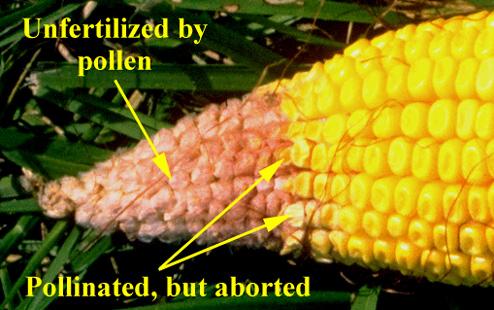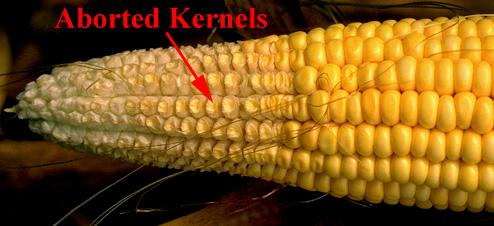Incomplete Kernel Set in Corn
R.L. (Bob) Nielsen , Agronomy Department , Purdue University, West Lafayette, IN 47907-1150
Internet address: rnielsen@purdue.edu
- Incomplete kernel set cuts yield potential
- Unsuccessful pollination is one culprit.
- Kernel abortion is another cause.
Now that silking and pollen shed are complete for most Indiana corn fields,
our attention turns to the important grain fill period (see 'Grain Fill Stages in Corn', P&C Newsletter,
8/16/96). As you take your daily hike through your corn fields (you do that,
don't you?), take the time to inspect kernel set on ears throughout the field.
Incomplete kernel set cuts grain yield directly and permanently.
The appearance of ear shoots can be very misleading. Husks and cob will
continue to lengthen even if kernel set is incomplete. A wonderfully long,
robust-looking, healthy green husk can completely mask even a 100 percent
failure of pollination. Incomplete kernel set may be caused by several factors,
sometimes working interactively.
Incomplete kernel set can be caused by unsuccessful pollination that results
in ovules that are never fertilized. Abortion of fertilized ovules is the other
cause of incomplete kernel set. Distinguishing between the two causes can help
you identify the most limiting factor. By the milk stage of kernel development,
aborted kernels will appear as shrunken, mostly white kernels, often
with a yellow embryo visible; in contrast to the normal, plump, yellow kernels.
Unsuccessful pollination simply leaves a blank spot on the cob, showing
cob tissue but no kernel.
 Unsuccessful
Pollination - Unsuccessful pollination results in ears with varying degrees
and patterns of incomplete kernel set. Certain insects like corn rootworm
beetles and Japanese beetles can interrupt pollination and fertilization by
their silk clipping action. These insects feed on pollen and will subsequently
clip silks as they feed on the pollen that has been captured by the silks.
Unusually early or late pollinating fields are often particularly attractive to
these insects.
Unsuccessful
Pollination - Unsuccessful pollination results in ears with varying degrees
and patterns of incomplete kernel set. Certain insects like corn rootworm
beetles and Japanese beetles can interrupt pollination and fertilization by
their silk clipping action. These insects feed on pollen and will subsequently
clip silks as they feed on the pollen that has been captured by the silks.
Unusually early or late pollinating fields are often particularly attractive to
these insects.
During periods of high temperatures, low relative humidities, and inadequate
soil moisture levels, exposed silks may dessicate and become non-receptive to
pollen germination. Drought stress may also delay silk emergence until pollen
shed is nearly or completely finished. Those areas of Indiana that experienced
severe and/or prolonged drought conditions during pollination will likely suffer
from unsuccessful pollination.
Unusually favorable conditions prior to pollination that favor ear size
determination can result in ears with an unusually high number of potential
kernels per row. Longer than normal potential ears often fail to silk
completely before the pollen source runs out. In this situation,
while an inch or more of the cob tip
may be blank, the rest of the ear may well contain a fairly normal (even
satisfactory) complement of kernels. Before complaining about the barren
tips, be sure to count the rest of the kernels. Remember that a typical
harvested ear size is 16 to 18 rows around by 30 to 40 kernels long.
 Kernel
Abortion - Recently fertilized ovules are very sensitive to stress of all
kinds, including sharply reduced rates of photosynthesis. Tip kernels are most
sensitive to stress since they are the youngest (most recently pollinated) yet
farthest from the incoming photosynthate supply.
Kernel
Abortion - Recently fertilized ovules are very sensitive to stress of all
kinds, including sharply reduced rates of photosynthesis. Tip kernels are most
sensitive to stress since they are the youngest (most recently pollinated) yet
farthest from the incoming photosynthate supply.
Severe drought stress that continues into the early stages of kernel
development (blister and milk stages), can easily abort developing kernels.
Severe nutrient deficiencies (especially nitrogen) can also abort kernels if
enough of the photosynthetic 'factory' is damaged. Extensive loss of green leaf
tissue by certain leaf diseases (e.g., grey leaf spot) by the time pollination
occurs may limit photosynthate production enough to cause kernel abortion.
Consecutive days of heavily overcast, cloudy conditions may also reduce
photosynthesis enough to cause abortion in recently fertilized ovules.
 Return to the the
Chat 'n Chew Cafe.
Return to the the
Chat 'n Chew Cafe.
 The Corn Growers Guidebook , a WWW resource
for corn management systems in Indiana and the eastern CornBelt.
The Corn Growers Guidebook , a WWW resource
for corn management systems in Indiana and the eastern CornBelt.
 Purdue University Agronomy Extension WWW
Home Page.
Purdue University Agronomy Extension WWW
Home Page.
 Purdue Agronomy On-Line! , Purdue's Agronomy
Department WWW Home Page.
Purdue Agronomy On-Line! , Purdue's Agronomy
Department WWW Home Page.
End of Document
 Unsuccessful
Pollination - Unsuccessful pollination results in ears with varying degrees
and patterns of incomplete kernel set. Certain insects like corn rootworm
beetles and Japanese beetles can interrupt pollination and fertilization by
their silk clipping action. These insects feed on pollen and will subsequently
clip silks as they feed on the pollen that has been captured by the silks.
Unusually early or late pollinating fields are often particularly attractive to
these insects.
Unsuccessful
Pollination - Unsuccessful pollination results in ears with varying degrees
and patterns of incomplete kernel set. Certain insects like corn rootworm
beetles and Japanese beetles can interrupt pollination and fertilization by
their silk clipping action. These insects feed on pollen and will subsequently
clip silks as they feed on the pollen that has been captured by the silks.
Unusually early or late pollinating fields are often particularly attractive to
these insects.  Kernel
Abortion - Recently fertilized ovules are very sensitive to stress of all
kinds, including sharply reduced rates of photosynthesis. Tip kernels are most
sensitive to stress since they are the youngest (most recently pollinated) yet
farthest from the incoming photosynthate supply.
Kernel
Abortion - Recently fertilized ovules are very sensitive to stress of all
kinds, including sharply reduced rates of photosynthesis. Tip kernels are most
sensitive to stress since they are the youngest (most recently pollinated) yet
farthest from the incoming photosynthate supply.  Return to the the
Return to the the